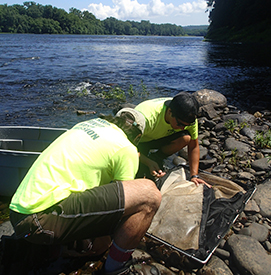Delaware • New Jersey • Pennsylvania
New York • United States of America
 |
 |
| Macroinvertebrates collected as part of an educational lesson. |
Benthic macroinvertebrates are bottom dwelling (benthic) animals and insect larvae that you can see without a microscope (macro) and don't have a backbone (invertebrate).
Simply, they are aquatic bugs.
They live in streams, lakes and rivers attached to rocks, vegetation and other plant debris or burrowed into the bottom sand and sediments.
Examples include aquatic insects, worms, crayfish, clams and snails.
They are an important part of the food chain. They feed on leaves and algae and fish feed on them.
Macroinvertebrates are commonly used by scientists as a biological indicator of water quality
• They are abundant in most streams and are relatively easy and inexpensive to sample;
• They are sensitive to environmental impacts;
• They are less mobile than fish, and thus cannot avoid discharges, spills, etc.;
• They are also able to detect non-chemical impacts to the habitat, such as siltation or thermal changes; and
• They bioaccumulate many contaminants, so that analysis of their tissues is a good monitor of toxic substances in the aquatic food chain.
Because of these reasons, studying macroinvertebrates helps provide an overall picture of water quality at a particular site. Finding species that are sensitive to pollution is an indicator of good water quality.
• Learn More: DRBC's Biomonitoring Program
The four Basin states also collect data to assess macroinvertebrates, as well as many additional groups. It is difficult to compare data due to differences in bioassessment protocols and analytical methods, but a qualitative comparison considers the Basin population of macroinvertebrates to be in good shape.
 |
 |
 |
| DRBC Aquatic Biologist Jake Bransky collects a sample from the Delaware River using a large net. Photo by DRBC. |
DRBC Aquatic Biologist Jake Bransky brings the collected sample from the river. Photo by DRBC. |
DRBC staff then collect, identify and count how many macroinvertebrates were found. Photo by DRBC. |
At outreach events across the Delaware River Basin, we use macroinvertebrates as an interactive educational lesson. We'll collect bugs from a local waterway and display them for folks of all ages to view and learn about. The lesson is simple: the amount and kind of macroinvertebrates found in a waterbody can help tell how clean it is. Some are very sensitive to pollution and others are more tolerant. Because the waters of the basin are generally healthy, we typically find several sensitive species, for example, mayflies, stoneflies and caddisflies, in our collections.
 |
 |
 |
| Kids and adults alike love looking at the trays of macroinvertebrates to see what they can find. Photo by DRBC. |
Kids can also become "Major Macro." This science superhero comes equipped with everything needed to study aquatic bugs. Photo by DRBC. |
We enjoy nothing more than seeing engaged kids eager to learn about what we do! Photo by DRBC. |
Identification Key
- Common Stream Invertebrates Sampled in the Non-Tidal Delaware River (pdf)
- Atlas of Common Freshwater Macroinvertebrates of Eastern North America
General Information
Copyright © Delaware River Basin Commission,
P.O. Box 7360, West Trenton, NJ 08628-0360
Phone (609)883-9500; Fax (609)883-9522
Thanks to NJ for hosting the DRBC website